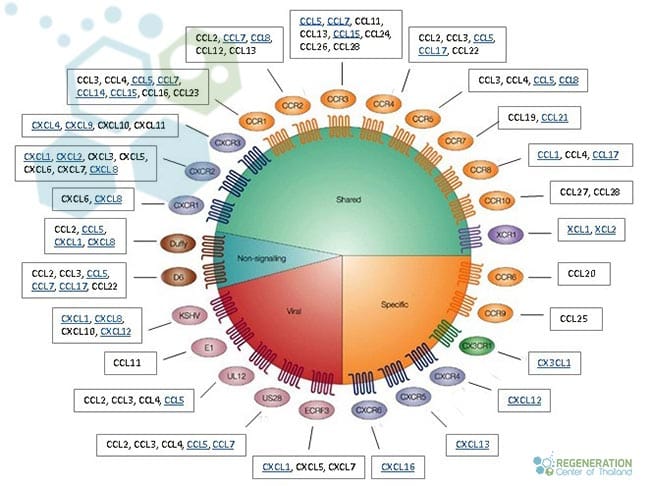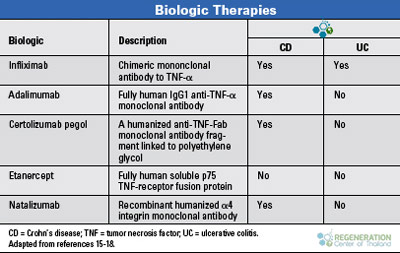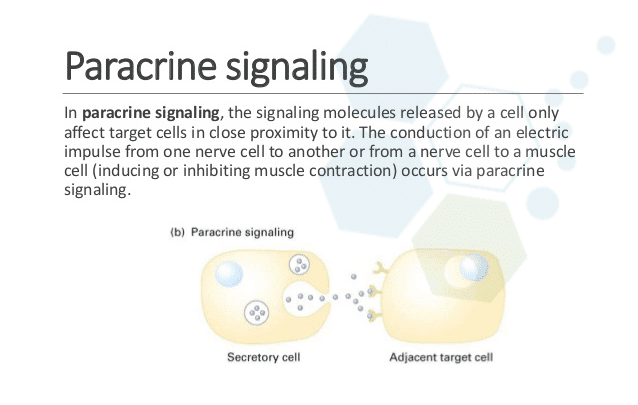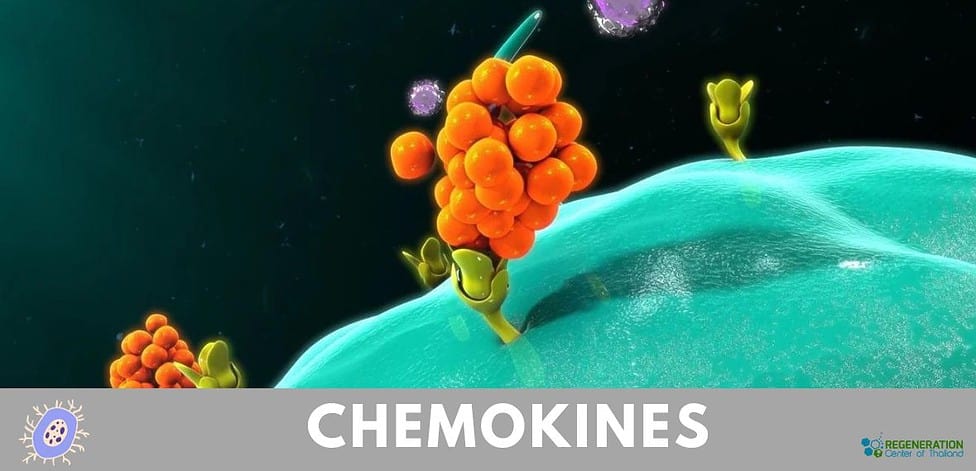Chemokines, critical components in the immune system, are small proteins that facilitate the migration and positioning of immune cells throughout the body. They are vital in maintaining the body’s defense against foreign invaders, such as bacteria and viruses. Understanding the fundamental principles of chemokine biology can significantly contribute to our knowledge and ability to help patients in the clinical and research settings.
Understanding the Basics of Chemokines
Chemokines have shed light on the intricate immune system network. This discovery in 1977 (CXCL4) has led to a deeper understanding of the immune response and potential therapeutic targets. Chemokines have a specific structure, and their synthesis is a complex process involving transcription and translation of genetic material. Their unique design allows them to bind to particular chemokine receptors on immune cells. This binding triggers a cascade of intracellular signals, leading to the migration of these cells to infection sites. Over time, the evolution of chemokines and their receptors has been studied extensively. It provides insights into the adaptive nature of the immune system, highlighting its dynamic capability to respond to various challenges. Part of this evolution involves the development of different chemokine subfamilies, each with distinct roles in immune response.

The Role of Chemokines in Immunity
Many immune responses within the human body involve the strategic function of chemokines, underscoring their indispensable role in maintaining health and fighting diseases. These small proteins act as signaling mechanisms, guiding immune cells to areas of infection or injury. They bind to specific chemokine receptors on the surface of cells, facilitating the migration of these cells to the site of Inflammation or infection.

The chemokine secretion process is dynamic and highly regulated, ensuring a rapid and efficient immune response. This process is critical in mounting a robust defense against invading pathogens and maintaining homeostasis within the body. However, the complexity of this system is also evident in the phenomenon of chemokine redundancy, where multiple chemokines can bind to the same receptor and vice versa. This redundancy provides a failsafe mechanism to ensure the continued functioning of the immune response, even when one chemokine is compromised.
Chemokine antagonists, which block the action of chemokines, are of great interest in medical research for their potential in modulating immune responses and treating inflammatory diseases. Their role in controlling the overactive immune response in conditions such as hashimotos and psoriasis.
The chemokine system has shown a remarkable capacity for evolution, adapting to different physiological and pathological conditions. The broad repertoire of chemokines and their receptors reflects this adaptability, which is a testament to their pivotal role in immunity. Understanding the functions and interactions of chemokines is critical for developing therapeutic strategies to harness their potential in promoting health and fighting diseases.
Chemokine Classifications and Types
Diving into the specifics, the broad array of chemokines can be classified into four main types based on the positioning of their first two cysteine residues. These classes are:
- C Chemokines
- CC Chemokines
- CXC Chemokines
- CX3C chemokines.
The classification is based on the chemokine structure, precisely the cysteine residues’ relative position in the protein’s N-terminal region. Chemokine gene expression varies significantly, with different cell types expressing other chemokines. This expression is modulated in response to various external stimuli, such as Inflammation or infection.
Chemokines interact with chemokine receptors on the surface of immune cells, triggering a cascade of intracellular signals that ultimately lead to cell migration. The specificity of the chemokine-receptor interaction determines the direction of cell migration, making chemokine receptors a crucial part of the immune response and neurogenesis.
Chemokine ligands, on the other hand, are the specific chemokines that bind to these receptors. They assist in regulating cell trafficking and positioning within tissues, representing an essential aspect of immune surveillance, Inflammation, and tissue repair.
Lastly, chemokine antagonists are molecules that block the binding of chemokines to their receptors. These antagonists can be naturally occurring proteins or synthetic drugs. These antagonists can modulate immune responses by inhibiting chemokine function and have potential therapeutic applications in treating various inflammatory and autoimmune diseases.
The Process of Chemokine Signaling
Transitioning from their classification and types, elucidating chemokine signaling is vital in comprehending how these complex molecules regulate immune responses. Several critical steps characterize this signaling process, including signal transduction, receptor binding, G protein coupling, initiation of signaling pathways, and cellular responses.

Signal transduction is the commencement of the chemokine signaling process. It involves the transformation of a chemical signal from outside the cell to a series of actions inside the cell. Following signal transduction, receptor binding initiates. Chemokines bind to their corresponding receptors on the cell surface, a crucial step ensuring the response’s specificity.
The next phase in the signaling process is G protein coupling. G proteins, functioning as molecular switches, regulate the transmission of signals from chemokine receptors to the inside of the cell. This coupling is pivotal in the activation of the subsequent signaling pathways.
The initiation of signaling pathways is a complex process that allows the cell to respond to the chemokine signal. These pathways involve protein interactions that ultimately lead to the desired cellular responses.
The final stage involves the cellular responses, which are the results of the signaling process. These may include cell migration, proliferation, or apoptosis, among others. The specific answer depends on the type of chemokine and the physiological context. In essence, chemokine signaling is a multifaceted process, and a comprehensive understanding of this process is fundamental to devising effective strategies for serving others in healthcare and medical research.
Chemokines vs cytokines
Chemokines and cytokines are both types of signaling molecules used by cells, especially in the immune system. Chemokines are a specific type of cytokine primarily responsible for inducing chemotaxis in nearby cells, meaning they guide the movement of cells towards or away from certain areas, particularly in response to inflammation or injury. They play a crucial role in the migration of immune cells to infection sites. Cytokines, on the other hand, are a broader category of signaling molecules that include chemokines but also encompass other types such as interferons and interleukins. Cytokines are involved in a wide range of cellular processes, including immune responses, inflammation, and cell growth and repair.
Disorders Linked to Chemokine Dysfunction
What implications does chemokine dysfunction hold for human health, particularly concerning various disorders? The answer lies in the broad spectrum of diseases that can result from chemokine gene mutations and the resulting dysfunction in the chemokine network. These disorders range from inflammatory diseases to cancer progression, emphasizing the critical role of chemokines in maintaining health and well-being.
Chemokine gene mutations can disrupt the chemokine network, which plays a crucial role in immune responses. This disruption can result in the onset of metabolic syndromes and inflammatory diseases.
For instance, the connection between chemokines and inflammatory diseases like rheumatoid arthritis, psoriasis, and atherosclerosis has been well-established in recent scientific literature. These diseases are characterized by an overactive immune response, often triggered by chemokines’ dysfunction. Furthermore, abnormal chemokine function is also implicated in cancer progression. Chemokines can influence tumor development by modifying the tumor microenvironment and promoting the migration of cancer cells, thus facilitating metastasis in patients with liver cancer, lung cancer and pancreatic cancer.
This chemokine-related cancer progression underscores the potential of chemokine-targeted therapies in combating cancer. In this context, the development of chemokine receptor antagonists has gained significant attention. These antagonists can block the interaction between chemokines and their receptors, thereby mitigating the adverse effects of chemokine dysfunction. By harnessing the power of chemokine-targeted therapies and chemokine receptor antagonists, The Regeneration Center can open new avenues for treating disorders linked to chemokine dysfunction, offering hope for those affected by these conditions.
Current Research on Chemokines
Advancement in understanding chemokines and their role in various disorders has sparked a surge in current research efforts to exploit chemokine pathways for therapeutic purposes. Much of this research is predicated on the premise that chemokines and their respective receptors play a pivotal role in the pathogenesis of numerous inflammatory and autoimmune diseases. One of the primary areas of this research is focused on chemokine receptors. These receptors are being studied for their potential as therapeutic targets due to their role in the recruitment and activation of leukocytes, which are integral to the inflammatory response in patients with Crohn’s and UC. The Regen Center has been developing chemokine antagonists to inhibit these receptors and curtail the inflammatory response.
Another crucial area of research is the exploration of chemokines in Inflammation. By understanding the mechanisms by which chemokines contribute to inflammation, it is possible to develop therapies that can modulate this response and alleviate the symptoms of diseases characterized by chronic Inflammation. In addition, there is ongoing research into chemokine gene expression. This research aims to understand how the expression of chemokine genes can be influenced to manipulate this expression for therapeutic benefit.
Lastly, the role of chemokine ligands in disease progression and resolution is a subject of active research. By understanding the role of these ligands, it may be possible to develop novel therapies that can hinder disease progression or facilitate resolution.
Future Prospects: Chemokines in Regenerative Medicine
The Regeneration Center understands chemokines’ power and potential application in medical treatments. Chemokine presents promising avenues for treating and managing various inflammatory and autoimmune diseases. Our progress in developing chemokine therapies has opened up exciting possibilities for novel interventions, paving the way for the future of personalized medicine. This is primarily due to the chemokines role in inflammation, which, when regulated, can minimize the harmful effects of chronic inflammatory diseases.
Chemokine receptor interactions are also being studied for their potential therapeutic applications.
These interactions can influence several physiological processes, most notably Chemokine-induced cell migration. The Regeneration Center harnesses this natural process to promote healing and tissue regeneration, which has applications in various medical fields, from wound healing, heart failure, osteoarthritis, knee injuries, shoulder injuries, back injuries, and hip injuries, multiple sclerosis to cancer treatments. Chemokine antagonists are another promising area of our research. By blocking the action of chemokines, these antagonists can prevent the exacerbation of Inflammation, offering relief to patients suffering from conditions like rheumatoid arthritis or psoriasis.
The future of regenerative medicine is inherently tied to our understanding of chemokines and their role in the body. As we delve deeper into this complex and fascinating field, we expect to see more targeted, effective treatments for various diseases. The road ahead is challenging, but the potential rewards for patient care are enormous. Our ability to serve others through applying this knowledge will continue to drive innovation and progress in chemokine research.
Chemokines play a crucial role in the immune system and disease progression. Continued investigations into the mechanisms of chemokine signaling and their impact on various disorders will undoubtedly contribute to developing innovative therapeutic strategies. Understanding chemokines, therefore, holds the promise of significant advancements in regenerative and functional medicine.

